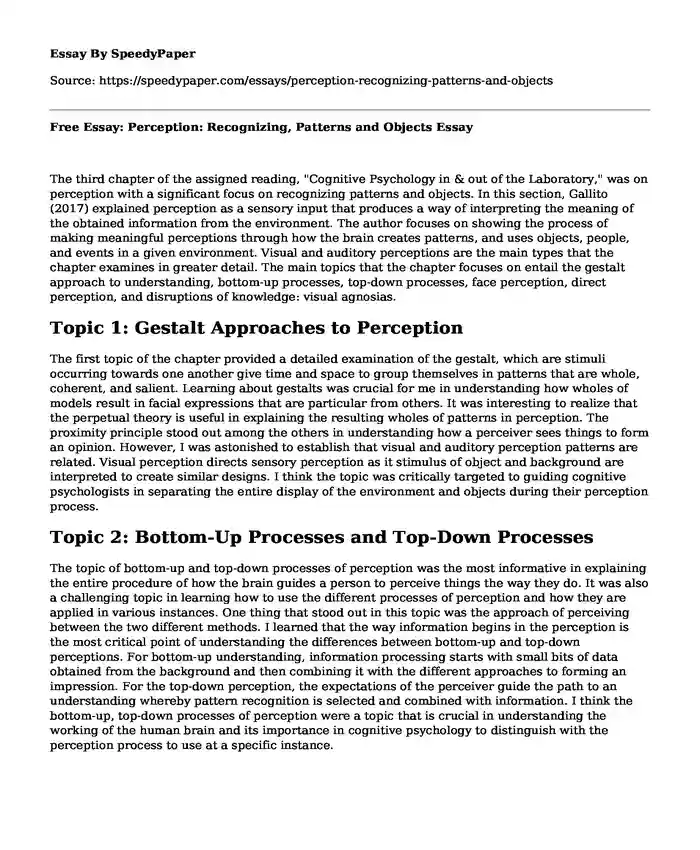
| Essay type: | Analytical essays |
| Categories: | Psychology Intelligence Cognitive development |
| Pages: | 3 |
| Wordcount: | 739 words |
The third chapter of the assigned reading, "Cognitive Psychology in & out of the Laboratory," was on perception with a significant focus on recognizing patterns and objects. In this section, Gallito (2017) explained perception as a sensory input that produces a way of interpreting the meaning of the obtained information from the environment. The author focuses on showing the process of making meaningful perceptions through how the brain creates patterns, and uses objects, people, and events in a given environment. Visual and auditory perceptions are the main types that the chapter examines in greater detail. The main topics that the chapter focuses on entail the gestalt approach to understanding, bottom-up processes, top-down processes, face perception, direct perception, and disruptions of knowledge: visual agnosias.
Topic 1: Gestalt Approaches to Perception
The first topic of the chapter provided a detailed examination of the gestalt, which are stimuli occurring towards one another give time and space to group themselves in patterns that are whole, coherent, and salient. Learning about gestalts was crucial for me in understanding how wholes of models result in facial expressions that are particular from others. It was interesting to realize that the perpetual theory is useful in explaining the resulting wholes of patterns in perception. The proximity principle stood out among the others in understanding how a perceiver sees things to form an opinion. However, I was astonished to establish that visual and auditory perception patterns are related. Visual perception directs sensory perception as it stimulus of object and background are interpreted to create similar designs. I think the topic was critically targeted to guiding cognitive psychologists in separating the entire display of the environment and objects during their perception process.
Topic 2: Bottom-Up Processes and Top-Down Processes
The topic of bottom-up and top-down processes of perception was the most informative in explaining the entire procedure of how the brain guides a person to perceive things the way they do. It was also a challenging topic in learning how to use the different processes of perception and how they are applied in various instances. One thing that stood out in this topic was the approach of perceiving between the two different methods. I learned that the way information begins in the perception is the most critical point of understanding the differences between bottom-up and top-down perceptions. For bottom-up understanding, information processing starts with small bits of data obtained from the background and then combining it with the different approaches to forming an impression. For the top-down perception, the expectations of the perceiver guide the path to an understanding whereby pattern recognition is selected and combined with information. I think the bottom-up, top-down processes of perception were a topic that is crucial in understanding the working of the human brain and its importance in cognitive psychology to distinguish with the perception process to use at a specific instance.
Topic 3: Face and Direct Perception
The subject of the face and direct perception explains a great deal of activity involved in the perception process of the perceiver. These approaches to knowledge require mental and physical activity to gather information regarding objects of interest in the perception process. The most interesting aspect that I learned from this topic was the models of perception applicable to the perceiver. I realized that it does not matter the form of judgment, collection of data is a core item in making meaning to every perceiving. Therefore, the perceiver never leaves navigating the world through the brain activity to obtain distal stimulus and interpret the proximal stimuli for everyday perception. One challenge that emerged in forming judgments from this topic was the presence of visual agnosias that impairs the ability of the perceiver to see visual information for face and direct perception.
Conclusion
In conclusion, the chapter on perception was critical in learning about the process, types, and models of perceiving information acquired from the environment. Gestalt approaches to understanding helped me in learning how stimuli form groups of patterns useful in the perception process. The bottom-up, top-down, and face, as well as direct perceptions, are valuable subjects for psychologists as they inform the field of cognitive psychology. Furthermore, proximal stimulus stands out in all models of understanding for the perceiver to create meaning from the obtained information to identify the object and use knowledge in filling the gaps from the observations.
Reference
Galotti, K. (2017). Cognitive psychology in and out of the laboratory. 6th Edition. Sage Publications, Inc. ISBN13: 9781506351568
Cite this page
Free Essay: Perception: Recognizing, Patterns and Objects. (2023, Sep 07). Retrieved from https://speedypaper.com/essays/perception-recognizing-patterns-and-objects
Request Removal
If you are the original author of this essay and no longer wish to have it published on the SpeedyPaper website, please click below to request its removal:
- Personal Essay Example: My Biggest Mistake
- Business Ethics Essay Example: Who am I?
- Grandpa's Christmas Story - Personal Experience Essay Example
- Free Essay. Sexual Deviance in the Society
- Essay Sample on Protective and Resilient Factors
- Free Essay Sample on Learning Python Programming Language
- Free Paper on Truthful Communication: A Path to Authentic Relationships and Spiritual Fulfillment
Popular categories




